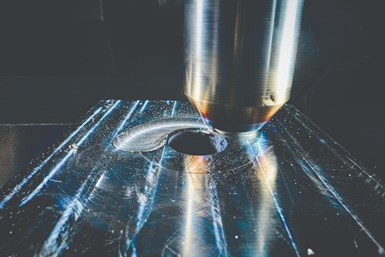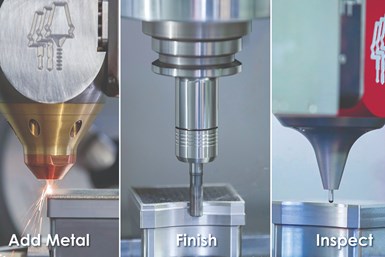Hybrid Manufacturing Turns Design Inside Out
Hybrid systems combine traditional subtractive processes with additional processes, including laser metal deposition for additive manufacturing and friction stir welding, enabling manufacturers to design products from the inside-out.

A rotating FSW tool plunges into the workpiece, dwells momentarily to enable rotation, friction and pressure to create a plasticized material pool, then traverses the workpiece to create the weld. Photo Credit: Mazak
Traditional manufacturing starts with a solid block of metal. Manufacturers think about how to mill, turn, grind and polish the part, move the part to the next manufacturing step, create subassemblies and bring parts together. Each activity occurs in distinct processing areas. Hybrid manufacturing disrupts that workflow.
Hybrid systems combine traditional subtractive processes with additional processes, including laser metal deposition (LMD) for additive manufacturing (AM) and friction stir welding (FSW). “Instead of designing products from outside-in, we can design from the inside-out, such as by sealing seam and then milling features. That’s really a paradigm shift in the way engineers think,” says Dale Fleck, general manager, Mazak MegaStir (IMTS booth: 338300).
Instead of using a stand-alone FSW system, which may have lower utilization rates, Mazak offers an alternative with its VTC-300c hybrid system, which offers everything users expect from a three-axis CNC, except that its powerful, 40-taper spindle also accepts FSW tools. Instead of multiple workstations, some parts can be “done in one.” This removes the time and labor associated with moving parts between machining and welding stations. It also removes potential sources of error, such as losing zero due to refixturing.
Super Multitasking
“Adoption of hybrid systems will accelerate when large manufacturers design parts that require internal structures,” says Jim Kosmala, vice president of engineering and technology, Okuma (IMTS booth: 338500). “That will inevitably occur because mechanical engineers understand the strength, weight and performance benefits of additive designs.”
The company’s MU-8000V Laser EX “super multitasking” CNC machine combines five-axis subtractive capabilities with LMD technology for AM, hardening and coating of workpiece blanks. By implementing LMD instead of laser metal fusion (LMF), this machine offers midprocess part inspection and material exchange, coolant use in work envelope, higher deposition rates and three-dimensional fabricating. A 4 kW Trumpf laser can supply power to up to four Laser EX machines.(Trumpf IMTS booth: 236217 and 433037)
More Revenue Streams

HMT has expanded the concept of “done-on-one machine” with product offerings that include metal and polymer AM, melt pool monitoring, inspection and more. Photo Credit: HMT
“Adding hybrid capabilities in-house opens up new revenue streams for mainstream manufacturers and job shops alike by giving them the power to control all steps of the production process,” says Lisa Block, director of global sales and marketing for Hybrid Manufacturing Technologies (HMT, IMTS booth: 432432). “Applications include repair, remanufacturer and feature enhancement. Our patented Ambit deposition heads extend part life cycle by adding layers of high-performance materials such as Inconel and stainless steel.”
HMT has proven its hybrid technology with industry leaders such as Mazak, Romi, Mitsui Seiki, Sugino and Tongtai. Originally, the company debuted the Ambit Flex platform for LMD designed to fit into a standard (CAT 40, HSK, etc.) toolholder for easy integration. In the subsequent years, HMT has released a vast array of product offerings, including but not limited to melt pool monitoring, various modes of inspection and polymer extrusion — all of which can be custom designed to fit any CNC, robot or gantry — further expanding the “done-on-one machine” concept.
To find how hybrid technology can bring more innovation to your manufacturing environment, register for IMTS 2022 and book your hotel now. IMTS 2022 runs Sept. 12-17, at Chicago’s McCormick Place.
Related Content
Video: For 3D Printed Aircraft Structure, Machining Aids Fatigue Strength
Machining is a valuable complement to directed energy deposition, says Big Metal Additive. Topology-optimized aircraft parts illustrate the improvement in part performance from machining as the part is being built.
Read MoreWhat Is the Role of Directed Energy Deposition (DED)? We Are Still Discovering It
The applications go well beyond repair. Recently posted articles find many different use cases for DED, including its expanded application for production parts.
Read MoreMachine Tool Drawbar Made With Additive Manufacturing Saves DMG MORI 90% Lead Time and 67% CO2 Emission
A new production process for the multimetal drawbar replaces an outsourced plating step with directed energy deposition, performing this DED along with roughing, finishing and grinding on a single machine.
Read MoreBig Metal Additive: The Difference Between a Shape and a Part Is Quality
Preparing to scale directed energy deposition to ongoing full production is not a technological challenge: DED is ready. But it is an organizational challenge, says the company founder. Here is what it means to implement a quality system.
Read MoreRead Next
Profilometry-Based Indentation Plastometry (PIP) as an Alternative to Standard Tensile Testing
UK-based Plastometrex offers a benchtop testing device utilizing PIP to quickly and easily analyze the yield strength, tensile strength and uniform elongation of samples and even printed parts. The solution is particularly useful for additive manufacturing.
Read More3D Printed Polymer EOAT Increases Safety of Cobots
Contract manufacturer Anubis 3D applies polymer 3D printing processes to manufacture cobot tooling that is lightweight, smooth and safer for human interaction.
Read MoreCrushable Lattices: The Lightweight Structures That Will Protect an Interplanetary Payload
NASA uses laser powder bed fusion plus chemical etching to create the lattice forms engineered to keep Mars rocks safe during a crash landing on Earth.
Read More



















